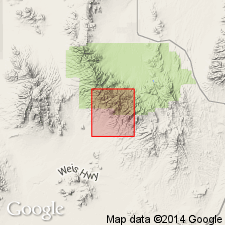
- Usage in publication:
-
- Ekker formation
- Modifications:
-
- Named
- Dominant lithology:
-
- Quartzite
- Tillite
- Graywacke
- AAPG geologic province:
-
- Southern Rocky Mountain region
Summary:
Named as the upper formation of Sheeprock group (first used). Intent to name and designation of a type not stated. Good exposures can be seen in Hard-to-Beat canyon in Tooele Co., UT in the Southern Rocky Mountain region. Mapped (geologic map) in north part of Dutch Peak area where seven map units --designated AA to GG --can be distinguished. Probably named for the Ekker Ranch in sec. 34, T10S, R6W. Is younger that the newly named Aut's Canyon formation, basal formation of Sheeprock group. Section 4,159 ft thick measured mostly in Hard-to-Beat Canyon, secs. 14 and 15, T10S, R6W. Unit AA at base is a 950 ft thick tan to brown, brown-weathering, iron-stained, medium to fine grained, medium- to thick-bedded, strongly jointed quartzite that contains mica partings and intercalated phyllitic and slaty quartzite. Unit BB is a 525 ft thick quartzite that varies from gray, brown, tan, to buff, is medium- to fine grained, thin to medium bedded, ledge and slope former. Unit CC is a spotted green, tan, gray tillite of fragments of granite, quartzite, gneiss, and slate that range from 2 mm to one half ft on diameter; the tillite has interbeds of graywacke and feldspathic quartzite; one buff, thin bedded to flaggy, slope-forming quartzite 87 ft thick lies 538 ft above base of unit CC. Unit DD is a 305 ft thick buff, medium grained, massive cliff-forming quartzite. Unit EE is a 298 ft thick mottled white and green tillite, brown phyllite. Unit FF is an 883 ft thick green, brown, tan spotted tillite mostly of pebble-to-cobble size fragments of quartzite, gneiss, granite and phyllitic quartzite; a 382 ft thick conglomeratic, green, fine to medium grained graywacke at top. Unit GG is a 40 ft thick gray, fine grained ledge-forming quartzite. Columnar section. Cross section. Intruded by Sheeprock stock of Tertiary age. Youngest sediments are Quaternary age. Assigned to the Precambrian. Source areas lay to the northwest and to the south.
Source: GNU records (USGS DDS-6; Denver GNULEX).
For more information, please contact Nancy Stamm, Geologic Names Committee Secretary.
Asterisk (*) indicates published by U.S. Geological Survey authors.
"No current usage" (†) implies that a name has been abandoned or has fallen into disuse. Former usage and, if known, replacement name given in parentheses ( ).
Slash (/) indicates name conflicts with nomenclatural guidelines (CSN, 1933; ACSN, 1961, 1970; NACSN, 1983, 2005, 2021). May be explained within brackets ([ ]).

